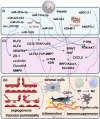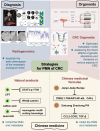Understanding pre-metastatic niche formation: implications for colorectal cancer liver metastasis
- PMID: 40098140
- PMCID: PMC11912654
- DOI: 10.1186/s12967-025-06328-2
Understanding pre-metastatic niche formation: implications for colorectal cancer liver metastasis
Abstract
The liver is the most commonly metastasized organ in colorectal cancer (CRC), and distant metastasis is the primary cause of mortality from CRC. In recent years, researchers have discovered that tumor cells create a "pre-metastatic niche (PMN)" favorable to metastasis before reaching the metastatic location. This review discusses the many processes and mechanisms that lead to PMN formation in CRC, including gut microbiota, stem cell stimulation, immunocyte interactions, and the induction of extracellular vesicles that carry important information. It examines research methods and diagnostic and therapeutic approaches for treating metastatic CRC with PMN. The crucial significance of PMN formation in metastatic CRC is also highlighted.
Keywords: Colorectal cancer; Liver metastasis; Pre-metastatic niche.
© 2025. The Author(s).
Conflict of interest statement
Declarations. Conflict of interest: No competing interest.
Figures




References
-
- Biller LH, Schrag D. Diagnosis and treatment of metastatic colorectal cancer: a review. JAMA. 2021;325:669–85. - PubMed
-
- Siegel RL, Miller KD, Wagle NS, Jemal A. Cancer statistics, 2023. CA Cancer J Clin. 2023;73:17–48. - PubMed
-
- de Cuba EM, Kwakman R, van Egmond M, Bosch LJ, Bonjer HJ, Meijer GA, te Velde EA. Understanding molecular mechanisms in peritoneal dissemination of colorectal cancer: future possibilities for personalised treatment by use of biomarkers. Virchows Arch. 2012;461:231–43. - PubMed
-
- Holladay L, Luu J, Balendra V, Kmetz K. Current and potential treatment of colorectal cancer metastasis to bone. Cancer Treat Res Commun. 2023;37:100763. - PubMed
Publication types
MeSH terms
Grants and funding
- 82374082/National Natural Science Foundation of China
- 82374045/National Natural Science Foundation of China
- ZT202111/the Science and Technology Development Project of traditional Chinese medicine of Jiangsu Province
- No. 2021.6/Jiangsu Clinical Innovation Center of Digestive Cancer of Traditional Chinese Medicine
LinkOut - more resources
Full Text Sources
Medical

